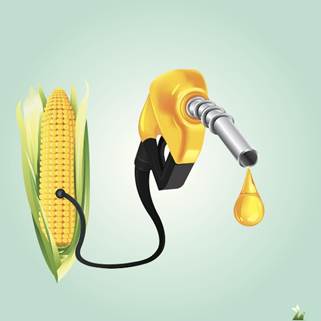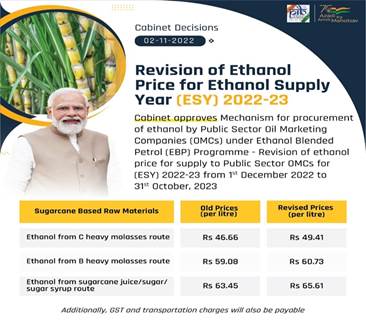Description

Disclaimer: Copyright infringement not intended.
Context
- The Cabinet Committee on Economic Affairs, CCEA approved the mechanism for ethanol procurement by public sector oil marketing companies under the Ethanol Blended Petrol program. It has approved a higher Ethanol price derived from different sugarcane-based raw materials under the program for the forthcoming sugar season.

Must Read Article: https://www.iasgyan.in/daily-current-affairs/ethanol-blending
Ethanol Blended Petrol (EBP) programme
- The government has been promoting the use of ethanol as a blend stock with main automotive fuel like petrol in line with the National Policy on Biofuels - 2018 under the Ethanol Blended Petrol (EBP) Programme.
- Ethanol Blended Petrol (EBP) programme was launched in 2003. The programme sought to promote the use of alternative and environment friendly fuels and to reduce import dependency for energy requirements.
- The ethanol blending programme is aimed at reducing the country’s dependence on crude oil imports, cutting carbon emissions and boosting farmers’ incomes.
- This programme has been extended to whole of India except Union Territories of Andaman Nicobar and Lakshadweep islands wherein OMCs sell petrol blended with ethanol up to 10%.
- The target of supplying petrol mixed with 10 percent ethanol (10 percent ethanol, 90 percent petrol) was achieved in June, ahead of the original schedule of November 2022. The Government has 20% blending target by 2025-26.

- The OMCs are to procure ethanol from domestic sources. Government has notified administered the price of ethanol since 2014. OMCs are advised to continue according priority of ethanol from 1) sugarcane juice/sugar/sugar syrup, 2) B heavy molasses 3) C heavy molasses and 4) Damaged Food grains/other sources, in that order.
Steps Taken
To increase indigenous production of ethanol the Government took multiple interventions like:-
- Re-introduction of administered price mechanism;
- Opening of alternate route for ethanol production;
- Amendment to Industries (Development & Regulation) Act, 1951 which legislates exclusive control of denatured ethanol by the Central Government for smooth movement of ethanol across the country;
- Reduction in Goods & Service Tax (GST) on ethanol meant for EBP Programme from 18% to 5%;
- Differential ethanol price based on raw material utilized for ethanol production;
- Extension of EBP Programme to whole of India except islands of Andaman Nicobar and Lakshadweep wef 01st April, 2019;
- Interest Subvention Scheme for enhancement and augmentation of the ethanol production capacity by Department of Food and Public Distribution (DFPD);
- Publication of Long-Term Policy on ethanol procurement.
Environmental costs of ethanol blending
- Because ethanol burns more completely than petrol, it avoids emissions such as carbon monoxide. However, tests conducted in India have shown that there is no reduction in nitrous oxides, one of the major environmental pollutants.
- A report by the Institute for Energy Economics and Financial Analysis (IEEFA) says that for India to meet its target of 20% ethanol blended in petrol by the year 2025, it will need to bring in 30,000 additional sq km of land to come under maize cultivation. Half that land can be used more efficiently to produce clean electricity from solar energy, they contend.
- Increasing production of food-based feedstock for ethanol manufacturing may not be the best use of land in a hungry country, Institute for Energy Economics and Financial Analysis contends. India ranked 101 of 116 countries on the World Hunger Index 2021. Further, land can be used far more efficiently for generating renewable power for Electric Vehicles (EV) than for growing crops for ethanol.
- Use of land on this scale to grow crops for ethanol production is questionable considering India's food security concerns, the fact that sugarcane is a water-guzzling crop, and the availability of damaged or surplus grains is uncertain. For example, on average, one tonne of sugarcane can produce 100 kg of sugar and 70 litres of ethanol. Cultivation of each kg of sugar requires 1,600 to 2,000 litres of water. Hence, one litre of ethanol from sugar requires about 2,860 litres of water.

Final Thought
- According to a Report by "Expert Committee on Roadmap for Ethanol Blending in India by 2025" immense benefits can accrue to the country by 20% ethanol blending by 2025, such as saving Rs 30,000 crore of foreign exchange per year, energy security, lower carbon emissions, better air quality, self-reliance, use of damaged food grains, increasing farmers' incomes, employment generation, and greater investment opportunities.
- But the ramifications of India's ethanol policy are far-reaching, and its implications for land use appear not to have been adequately considered.
- A careful evaluation of both the target blending level and its timeframe is needed, considering land use, food security and other issues confronting the rural sector in particular.
- To achieve the key goal, that is emissions reduction, alternative mechanisms--enhanced EV uptake, installation of additional renewable generation capacity to allow zero-emissions recharging, etc.--need to be evaluated.
https://newsonair.gov.in/News?title=CCEA-approves-higher-ethanol-price-derived-from-different-sugarcane-based-raw-materials-under-Ethanol-Blended-Programme&id=450278

















